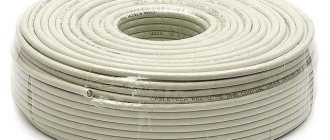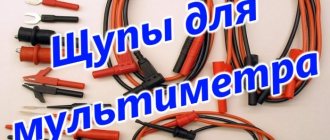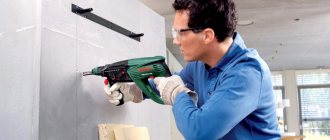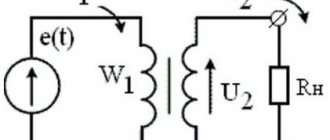Content:
- 1 Definition of electrical cable
- 2 Structure of the television conductor
- 3 Marking
- 4 What to look for when selecting a cable? 4.1 Protective layer material
- 4.2 Mechanical strength
- 4.3 Screen Features
- 4.4 Cable length and thickness
- 4.5 Outer shell
- 4.6 Central core
- 4.7 Manufacturer
- 4.8 Dielectric layer
When choosing a coaxial cable for a TV, you will notice that various types and brands of cable products are offered for sale to customers. Before purchasing coaxial wire, it is recommended that you familiarize yourself with the characteristics and differences between different product models, as well as the characteristics of its design.
Wires in grooves
When looking for shelter for communications, ensure the integrity of the insulation and avoid friction and kinks in the cable. You can’t just shove annoying wires behind a closet—they don’t joke with electricity.
The most prudent owners plan the installation of cable networks in advance, marking niches for grooves in which wires laid in corrugations and fastened with staples will be placed. All communications are output to a common console with the required number of outputs, and upon completion of the network wiring, the grooves are plastered.
TV hidden in the floor mirror.
A wall-hung TV with wiring built into the wall is an ideal option in terms of aesthetics, convenience and safety.
Webs of cables do not spoil the appearance of the wall decoration; small children and pets cannot reach the wires. In this case, there is no need to make holes in the entire wall - the wires can be routed under the floors, baguettes and door frames, fortunately, many manufacturers have already bothered to produce skirting boards with removable top panels and recesses for cables.
Electrical cable definition
Coaxial (coaxial cable) is a telecommunications element that allows you to simultaneously broadcast a certain number of high-frequency signals with minimal losses. Its operation is based on the potential difference that appears in the presence of two different metal conductors, separated from each other by means of a guide insulating layer. Why is coaxial cable needed?
Insulated cores are used in devices that transmit industrial and satellite television signals in automatic and alarm systems or computer networks.
Wires as an interior detail
Sometimes there is no better way to disguise questionable elements of the environment than to place them in a visible place.
Original author's compositions are assembled from long wires that support the theme and general mood of the interior. Before you start assembling, draw up a diagram of the location of the wires, then transfer the sketch to the surface of the working wall and measure the length of the main sections with nylon thread. Drawings made of wires in colored casings with figured overlays, continuing the wall painting, look very interesting.
If the color design of the cables does not suit you, collect all the wiring in an extension cord - the choice of shades and textures will noticeably expand.
Short wires are decorated with edging and overlays.
A cable decorated with an LED garland adds intrigue to the decor, and to create ethnic accents, massive beads are strung onto thin wires. In children's communication they decorate with stickers and funny figures, and in a romantic girl's bedroom - with artificial flowers, lace and feathers.
To secure cables, it is convenient to use ready-made plastic fasteners - invisible or shaped.
By combining different decorative techniques, you will turn your cable system into a spectacular installation that will look fresh and unusual. Feel free to experiment: the most unexpected solution will most likely turn out to be successful!
TV conductor structure
Getting acquainted with the structural properties of the cable for a TV, you will notice that all models provide for a similar systematization of the internal element:
- Coaxial is a conductor that affects signal transmission. It is made from copper tube, solid wire or stranded material. The quality of the raw materials influences the permissible bending coefficients and the signal.
- Dielectric is a plastic layer that acts as a conductor retainer.
- Metallized thickness is a combination of polyester with copper or aluminum.
- The metal braid is made of foil and thin wire. The more complete its weave, the better the quality of the cable and the degree of protection from external influences (radiation, moisture).
- The outer casing protects all structural components of the electrical wire.
The differences between the products lie mainly in the characteristics of the material used.
When solving the problem of which television cable is better to choose, you need to decide on your goals. For example, if the signal distance is minimal, it is not recommended to overpay for an expensive cable.
Wires as an interior detail
Sometimes there is no better way to disguise questionable elements of the environment than to place them in a visible place.
Graphic patterns made from wires are a new look at wall decor.
Original author's compositions are assembled from long wires that support the theme and general mood of the interior. Before you start assembling, draw up a diagram of the location of the wires, then transfer the sketch to the surface of the working wall and measure the length of the main sections with nylon thread. Drawings made of wires in colored casings with figured overlays, continuing the wall painting, look very interesting.
If the color design of the cables does not suit you, collect all the wiring in an extension cord - the choice of shades and textures will noticeably expand.
Short wires are decorated with edging and overlays.
A cable decorated with an LED garland adds intrigue to the decor, and to create ethnic accents, massive beads are strung onto thin wires. In children's communication they decorate with stickers and funny figures, and in a romantic girl's bedroom - with artificial flowers, lace and feathers. To secure cables, it is convenient to use ready-made plastic fasteners - invisible or shaped.
A little imagination and decor - and the cable will turn into a flowering tree! By combining different decorative techniques, you will turn your cable system into a spectacular installation that will look fresh and unusual. Feel free to experiment: the most unexpected solution will most likely turn out to be successful!
How to hide TV wires on the wall
A cord sticking out in plain sight can ruin all the designers' efforts. Before hanging your TV on the wall, consider how to disguise the cable system so that the wires are not obvious.
Marking
Laying and connecting a coaxial antenna cable does not require any special skills or knowledge in this area. It is much more difficult to choose an electrical cable taking into account the specifics of television transmission of information. To understand which option is better to buy, it is recommended to consider the labeling and initial data of the products.
Coaxial cable brands:
TV repairs are 30% cheaper
than in service centers near your home
Order repairs
- RG – 6 has gained popularity due to its low price and good properties. Suitable for interior work.
- RG-59, a thin cable that receives all types of signals, loses its characteristics at a distance of more than 190 m.
- PK 75 from the Russian manufacturer provides a copper core and braid, as well as a double protective stage made of tinned copper and aluminum.
- The SAT 703 brand has a characteristic impedance of 75 Ohms, as well as a double screen.
- SAT 50 from the Italian brand has an enhanced degree of protection.
- DG 113 is the most expensive antenna coaxial cable, but increased shielding values transmit high-level signals.
Wires in grooves
When looking for shelter for communications, ensure the integrity of the insulation and avoid friction and kinks in the cable. You can’t just shove annoying wires behind a closet—they don’t joke with electricity.
TV hidden in the floor mirror.
A wall-hung TV with wiring built into the wall is an ideal option in terms of aesthetics, convenience and safety.
Webs of cables do not spoil the appearance of the wall decoration; small children and pets cannot reach the wires.
In this case, there is no need to make holes in the entire wall - the wires can be routed under the floors, baguettes and door frames, fortunately, many manufacturers have already bothered to produce skirting boards with removable top panels and recesses for cables.
What to look for when selecting a cable?
Before you go to the store, you should figure out which antenna cable for your TV is best to buy. First, it is recommended to find out the following parameters:
- number and type of connected television equipment;
- location of the signal resource - loggia or roof;
- what space is intended for laying - an apartment or a large country house;
- terms of Use;
- format of the stored signal – type of broadcasting (analog or digital);
- total length of the network.
For high-quality signal reception, each TV antenna cable must have a resistance coefficient of less than 75 ohms.
Protective layer material
To increase strength, additives are added to plastic to reduce the negative impact of atmospheric factors. This TV cable is more expensive and is intended for laying external lines. Indoors, it is better to use cheap types of low-current cables.
Important: Some product manufacturers produce polymer layers from recycled materials. As a result, the cost of products decreases, and the profit of the enterprise increases.
Recyclable materials are obtained after processing various wastes. As a result of prolonged use, they lose their original characteristics, have low mechanical strength and are susceptible to ultraviolet radiation.
Distance from signal source to consumer
Signal leakage in the conductors occurs despite the reduced resistance. The longer the distance, the larger they are. It is recommended to reduce the negative impact by increasing the cross-section. The further the television panel is located from the internal electrical wiring or antenna, the thicker the TV wire will be needed.
Important: For extremely large diameters, specific adapters should be selected to connect consumers and lines.
Mechanical strength
To check the strength of polyethylene, you need to lean the element against the tensile load segment, and 2-3 times. bend and unbend the wire. If it is clear that the polymer has quickly cracked or stretched out, then it is not advisable to buy cable products.
Screen Features
It is recommended to buy an antenna cable for digital television with at least 2 shielding layers. This factor protects the signal from the influence of an external field (electromagnetic or magnetic). Modern versions of cable products include a layer of foil and a special winding made of thinner wire.
Cable length and thickness
These parameters will allow a non-professional person to learn about the technical features of the electrical wire. Thin coaxial cable is easier to lay and hide in a box. But at the same time there will be comments on the quality of the transmission. At home, conductive conductors with a cross-section of at least 3.5 mm are used.
If we consider the length of the conductor, then to prevent problems with installation it is necessary to have an electrical cable with a reserve. It will come in handy if some area is damaged during work and needs to be replaced. The second factor is rearranging the furniture. It is possible that the television panel will be moved, and this will require a longer coaxial cable.
The choice of electrical cable involves determining the length of the network. The longer it is, the thicker the cable you need to choose.
Outer shell
There are models in black and white. Dark products are covered with a polyvinyl chloride shell, and light ones are covered with polyethylene film. For street wiring, only black wire was used, but nowadays white SAT 703 brand is often chosen. This universal option is suitable for installation both outside and inside. It is also necessary to take into account the thickness of the outer coating. The larger it is, the more reliable and secure the connection will be. At the same time, the flexibility of the structure is significantly reduced and the bending radius is limited.
Central vein
The channel core is made primarily of copper or other durable metal alloys. The option with a copper core is considered the most reliable and resistant to damage. Its thickness is also taken into account; this indicator ranges from 0.3-1 mm.
Manufacturer
The electrical accessories market offers customers a wide range of antenna wires for TVs. This affects manufacturers and technical features of products. Experts advise purchasing products from well-known brands, which have many advantages.
Experts suggest focusing on offers from the following companies:
- Mediaflex;
- Cavel;
- commscope;
- Belden.
The manufacturer is not considered the main factor when purchasing. First, the technical criteria of the television cable are determined.
Dielectric layer
The interlayer serves to fix the conductor and insulation. For these purposes, foamed polyvinyl chloride is used. There are also polyethylene, fluoroplastic options made of polyethylene or an air shell.
Wires behind TV and furniture
The apartment has already been renovated and there is no way to do hidden wiring? Try hiding the wires behind your TV.
The main thing is to choose the right bracket: if all the sockets fit at a distance from the edges of the television receiver, the wires will not be visible.
Mark the locations for the sockets with chalk or stylus, use a grinder to cut two parallel vertical strips for the grooves at intervals of 2–3 centimeters, and hollow out the inner surface with a hammer drill to the desired depth. Next, drill the required number of holes for the sockets with diamond core bits and begin laying the wires.
If this is your first time holding a construction tool in your hands, it is better not to take on wall-shaping. Hide the wires behind mirrors, shelves, wall units, frames and decorative items - vases, ottomans, curtains, dried bouquets and living plants, securing the cable with electrical tape.
A modular TV stand serves as a shelter for wires and thousands of useful little things.
Transformable furniture makes things much easier - just free up the space where the TV is located, and all the cords will be behind the cabinets and shelves.
Carved TV frames are an elegant move. You can also choose a nice cabinet or wall panel with a built-in niche for cable systems, closed by a door or panel. The most radical solution is to install a TV from a centralized station: no wires - no problems!
The bench under the TV looks strange, but it masks the wiring well.
Recommendations for use
To ensure that your digital television cable lasts a long time, it is advisable to follow these recommendations:
- when choosing a product, you need to select brands that have good wave capacity;
- for laying electrical wires in extreme conditions and on the street, it is better to buy options with special impregnation;
- You should not lay the coaxial television cable near electrical appliances, they may interfere;
- When laying a conductor, it is necessary to make a minimum of connections and solders; a large number of them has a bad effect on the properties of the signal. A good solution is to lay a continuous shell;
- When installing and connecting the electrical wire, you must follow the manufacturer's instructions. Particular emphasis is placed on the gap between the fasteners and the bending line;
- It is better to use branded devices for branching. Electric amplifiers and splitters are placed at accessible points. If a breakdown occurs, repairs are easier to do.
Keep all the necessary wires at hand
We can’t hide all the cables in a box: we need some of them almost constantly. The solution is simple: secure them to the edge of your desktop so that if necessary, you can reach out and connect the device to the desired wire.
Sugru will help us with this - plasticine-rubber and one of the most irreplaceable things in the household. Don't believe me?
Roll Sugru into small balls and secure them to a table support. Then use a utility knife to remove some of the plasticine (be careful, try not to deform the balls too much).
Life hack: to prevent the plasticine from sticking to the blade, first rinse it with soapy water. Then adjust the shape a little with a sushi stick or toothpick to create neat hollows (they should be slightly wider than your wires). Everything is ready, you can fix the cables.
There is an option for those who know how to work with wood. A small block with holes will help organize all the wires on your desktop.
The simplest solution is to pass the wires through binders attached to the tabletop.
Subtleties of choice
Experts have identified nuances that are important to consider when selecting a cable for digital television:
- The thickness of the electrical wires is determined by the length of the laying route. The distance from the antenna to the equipment affects the attenuation of the television signal;
- do not forget about the location of electrical wiring or utilities that create an electromagnetic environment;
- It is advisable to select a cable for the TV antenna with a double protective layer;
- if the antenna is located nearby - on a balcony or on television equipment, then a coaxial wire with a diameter of 6 mm will be sufficient. To place it on the roof of a country house or on top of a multi-story building, you need to take a size of 7 mm;
Important: a copper core is required for satellite transmission; budget variations are suitable for all other channels. In the store you need to take a good look at the cut and properties of the inner core.
Wires behind TV and furniture
The apartment has already been renovated and there is no way to do hidden wiring? Try hiding the wires behind your TV.
The main thing is to choose the right bracket: if all the sockets fit at a distance from the edges of the television receiver, the wires will not be visible.
Mark the locations for the sockets with chalk or stylus, use a grinder to cut two parallel vertical strips for the grooves at intervals of 2–3 centimeters, and hollow out the inner surface with a hammer drill to the desired depth. Next, drill the required number of holes for the sockets with diamond core bits and begin laying the wires.
If this is your first time holding a construction tool in your hands, it is better not to take on wall-shaping. Hide the wires behind mirrors, shelves, wall units, frames and decorative items - vases, ottomans, curtains, dried bouquets and living plants, securing the cable with electrical tape.
Transformable furniture makes things much easier - just free up the space where the TV is located, and all the cords will be behind the cabinets and shelves.
You can also choose a nice cabinet or wall panel with a built-in niche for cable systems, closed by a door or panel. The most radical solution is to install a TV from a centralized station: no wires - no problems!
Connection method
Having selected a suitable coaxial cable, you need to make sure that your existing equipment has a special connector. Most often there are F-connectors, less often N-varieties.
Fasteners come in the form of crimp plugs or screw plugs. The simplest connection method is a plug (angled or straight). Step by step execution:
- Using a knife, cut the outer layer to a length of 15 mm and remove it. Wrap the conductor screen with foil. Remove the insulation from the core and wrap it around the plug.
- Cut the protruding main core to the required length.
- Screw the crimp circle onto the edge, cut the insulating layer to a length of 6 mm and remove it.
- Remove the layers of copper tube from the cleaned segment. These manipulations should be done with care so as not to damage the element or interfere with signal transmission.
- Place and slide the fork lengthwise until the inner fibers emerge from the middle.
- Insert the connector into the edge of the wire and secure with a crimp ring.
- Cut off protruding wires.
Coaxial cable is one of the important components of antenna installations. This factor is often overlooked and underestimated when purchasing a conductive cable for analog, satellite or digital broadcasting.
Found a mistake? Select it and press ctrl+enter
- 100
Secure the wires under the tabletop
To secure the wires and extension cord under the table, you will need binders and screws (their length should be at least a quarter less than the thickness of the table top, otherwise they will go right through and the table will be damaged). First of all, attach an extension cord under the tabletop, preferably in the middle of the table or closer to the wall.
Then secure the binders in the required places using screws. Connect everything you need to the extension cord and collect the wires with clamps. Visually the table has become much cleaner and neater.
There is a simpler option if you don’t need to hide a large number of wires. To do this you will need a construction stapler.
To prevent the long wire from the lamp from dangling under your feet, carefully secure it with paper clips at the table leg. A small extension can also be secured with paper clips. For thicker wires it is better to use special clamps
Stapler clips aren't your thing?
Regular zip ties will do. Secure the wire to the table leg with zip ties. Wires that run along the floor can be covered with plastic or a board that matches the color of the floor.
The extension can be secured under the tabletop using wide Velcro: secure it to the back of the tabletop with screws, and then attach the extension. To prevent wires from dangling under the table, run them through cable channels - they can be purchased at any hardware store.
You can fix the channels themselves with electrical tape or a regular plaster.
Useful tips from experts
To ensure that your equipment lasts a long time and never falls off the wall, we recommend that you consider the following tips for installing a wall-mounted TV:
When purchasing brackets (usually they are not included), be sure to check with the seller what diagonal and weight of the device they are designed for. A fixed mount is much more reliable than a rotating mount, although it reduces viewing comfort.
If you decide to install the TV in a plaster niche (which is fashionable lately), consider the possibility of air circulation, otherwise the case will overheat, which will eventually cause serious damage. A suspended screen can be secured with a homemade plasterboard stand.
It won’t take much time to do it, but security will noticeably increase. Do not place the screen above a home fireplace or other types of heaters. The radiated heat will also negatively affect the performance and service life of the equipment.
First, you must hang the TV securely on the wall, and then connect all the wires.
Please note that if the brackets are rotating, the length of the wires should be enough to rotate the screen in both directions (without tension). The optimal distance from the screen to the viewing area should be from 3 to 4 diagonal sizes.
That's all you need to know before installing the TV on the wall with your own hands. As you can see, everything is quite simple, the main thing is to approach the installation responsibly and play it safe - take a partner with you.
Well, now it's time to finish the article. All the material I wanted to share has been reviewed. I hope it will be useful to you, and you will use it if you need to run wires to the TV on the wall. Improve your own practical skills and gain new knowledge, as they say: “It’s never too late to learn!” That's all, thank you for your attention, successful and easy repair!











